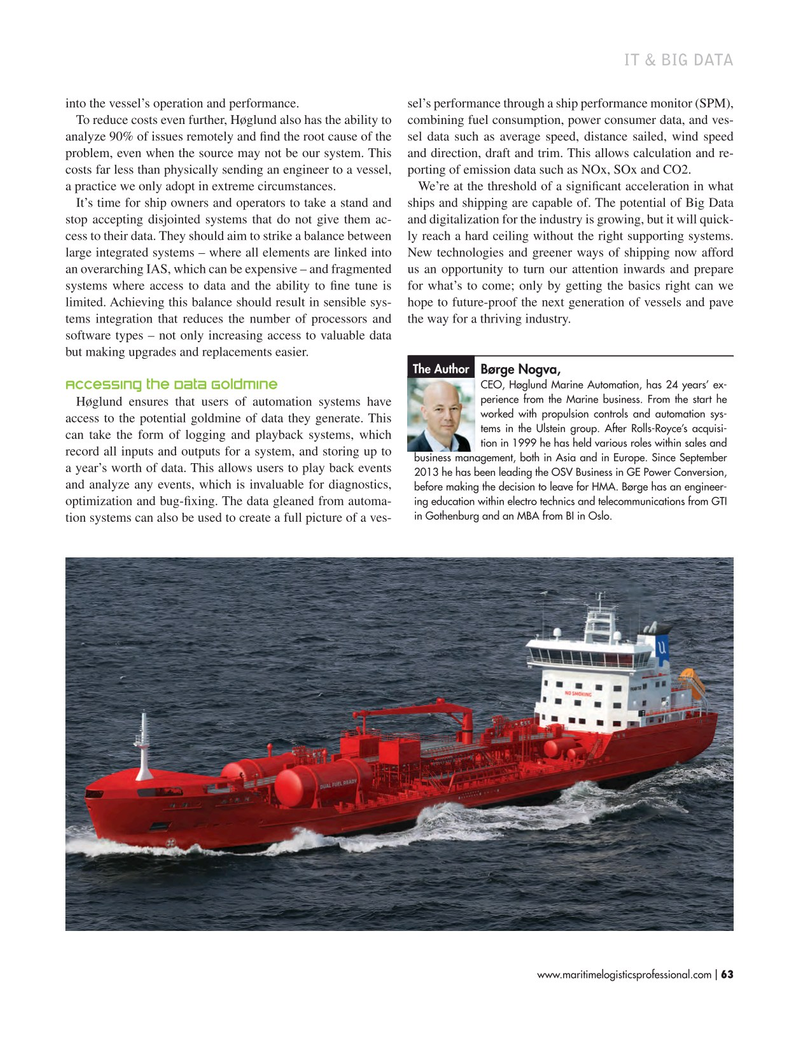
Page 63: of Maritime Logistics Professional Magazine (Mar/Apr 2018)
IT & Software
Read this page in Pdf, Flash or Html5 edition of Mar/Apr 2018 Maritime Logistics Professional Magazine
IT & BIG DATA into the vessel’s operation and performance. sel’s performance through a ship performance monitor (SPM),
To reduce costs even further, Høglund also has the ability to combining fuel consumption, power consumer data, and ves- analyze 90% of issues remotely and fnd the root cause of the sel data such as average speed, distance sailed, wind speed problem, even when the source may not be our system. This and direction, draft and trim. This allows calculation and re- costs far less than physically sending an engineer to a vessel, porting of emission data such as NOx, SOx and CO2. a practice we only adopt in extreme circumstances. We’re at the threshold of a signifcant acceleration in what
It’s time for ship owners and operators to take a stand and ships and shipping are capable of. The potential of Big Data stop accepting disjointed systems that do not give them ac- and digitalization for the industry is growing, but it will quick- cess to their data. They should aim to strike a balance between ly reach a hard ceiling without the right supporting systems. large integrated systems – where all elements are linked into New technologies and greener ways of shipping now afford an overarching IAS, which can be expensive – and fragmented us an opportunity to turn our attention inwards and prepare systems where access to data and the ability to fne tune is for what’s to come; only by getting the basics right can we limited. Achieving this balance should result in sensible sys- hope to future-proof the next generation of vessels and pave tems integration that reduces the number of processors and the way for a thriving industry.
software types – not only increasing access to valuable data but making upgrades and replacements easier.
The Author
Børge Nogva,
CEO, Høglund Marine Automation, has 24 years’ ex-
Accessing the Data Goldmine perience from the Marine business. From the start he
Høglund ensures that users of automation systems have worked with propulsion controls and automation sys- access to the potential goldmine of data they generate. This tems in the Ulstein group. After Rolls-Royce’s acquisi- can take the form of logging and playback systems, which tion in 1999 he has held various roles within sales and record all inputs and outputs for a system, and storing up to business management, both in Asia and in Europe. Since September a year’s worth of data. This allows users to play back events 2013 he has been leading the OSV Business in GE Power Conversion, and analyze any events, which is invaluable for diagnostics, before making the decision to leave for HMA. Børge has an engineer- ing education within electro technics and telecommunications from GTI optimization and bug-fxing. The data gleaned from automa- in Gothenburg and an MBA from BI in Oslo.
tion systems can also be used to create a full picture of a ves- www.maritimelogisticsprofessional.com 63
I

 62
62

 64
64
